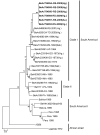Yellow fever virus in Haemagogus leucocelaenus and Aedes serratus mosquitoes, southern Brazil, 2008
- PMID: 21122222
- PMCID: PMC3294583
- DOI: 10.3201/eid1612.100608
Yellow fever virus in Haemagogus leucocelaenus and Aedes serratus mosquitoes, southern Brazil, 2008
Abstract
Yellow fever virus (YFV) was isolated from Haemagogus leucocelaenus mosquitoes during an epizootic in 2001 in the Rio Grande do Sul State in southern Brazil. In October 2008, a yellow fever outbreak was reported there, with nonhuman primate deaths and human cases. This latter outbreak led to intensification of surveillance measures for early detection of YFV and support for vaccination programs. We report entomologic surveillance in 2 municipalities that recorded nonhuman primate deaths. Mosquitoes were collected at ground level, identified, and processed for virus isolation and molecular analyses. Eight YFV strains were isolated (7 from pools of Hg. leucocelaenus mosquitoes and another from Aedes serratus mosquitoes); 6 were sequenced, and they grouped in the YFV South American genotype I. The results confirmed the role of Hg. leucocelaenus mosquitoes as the main YFV vector in southern Brazil and suggest that Ae. serratus mosquitoes may have a potential role as a secondary vector.
Figures


References
-
- Carvalho VL, Nunes MRT, Silva EVP, Gomes M, Casseb SM, Rodrigues SG, et al. Isolamento do vírus da febre amarela em células c6/36 a partir de lotes de mosquitos capturados em jataí—GO. In: 44° Congresso da Sociedade Brasileira de Medicina Tropical, 2008, Porto Alegre/RS. Rev Soc Bras Med Trop. 2008;41:2008.
-
- Ministério da Saúde. Brasil. Secretaria de Vigilância em Saúde. 2010. Febre Amarela Silvestre, Brasil: Boletim de atualização dezembro de 2009 [cited 2010 Jan 24]. http://portal.saude.gov.br/portal/default.cfm
-
- Ministério da Saúde. Brasil. Secretaria de Vigilância em Saúde. 2009. Febre Amarela: aspectos epidemiológicos [cited 2009 Sep 19]. http://portal.saude.gov.br/portal/saude/profissional/visualizar_texto.cf...
Publication types
MeSH terms
LinkOut - more resources
Full Text Sources
Medical
